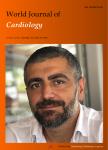Assessment of right ventricular afterload by pressure waveform analysis in acute pulmonary hypertension
Assessment of right ventricular afterload by pressure waveform analysis in acute pulmonary hypertension作者机构:Department of Pathophysiology. Hospital de Clínicas Facultad de Medicina. Universidad de la República Area del Cor. Hospital Universitari Vall d'Hebron. Passeig Vall d'Hebron 119-129 Department of PhysiologyUniversitat Autono- ma Barcelona 08193 Bellaterra (Cerdanyola del Vallès)
出 版 物:《World Journal of Cardiology》 (世界心脏病学杂志(英文版)(电子版))
年 卷 期:2011年第3卷第10期
页 面:322-328页
学科分类:10[医学]
基 金:Supported by Comisión Sectorial de Investigación Científica Universidad de la República and Programa de Desarrollo de las Ciencias Básicas
主 题:Pulmonary hypertension Time-domain analysis Augmentation index Characteristic imped- ance Reflected wave
摘 要:AIM: To characterize hydraulic right ventricle (RV) af- terload by pulmonary arterial pressure waveform analy- sis in an acute pulmonary hypertension (PH) model. METHODS: Pulmonary artery (PA) flow and pressure were recorded in six anesthetized sheep. Acute iso- baric PH was induced by phenylephrine (active) and PA mechanical constriction (passive). We estimated the amplitude of the forward and reflected pressure waves according to the inflection point. In most cases the in- flection pressure was smooth, thus the inflection point was defined as the time at which the first derivative ofpulmonary arterial pressure reached its first minimum. We calculated the input and characteristic (Z C , time- domain Li method) impedances, the capacitance index (stroke volume/pulse pressure), the augmentation index (AI) (reflected pressure/pulse pressure), the frac- tional pulse pressure (pulse pressure/mean pressure) and the wasted energy generated by the RV due to wave reflection during ejection (E W ). RESULTS: Pulse pressure, fractional pulse pressure, AI and Z C increased and capacitance index decreased during passive PH with respect to control (P 0.6, P 0.05). CONCLUSION: PA pressure waveform analysis al- lows the quantification of the dynamic RV afterload. Prospective clinical studies will be necessary to validate this time-domain approach to evaluate the dynamic RV afterload in chronic PH.



